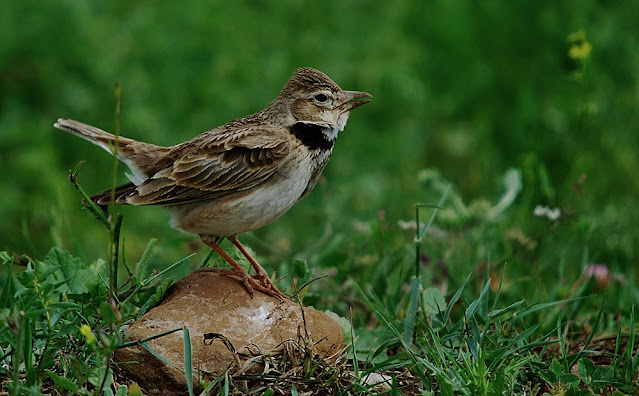¿Es posible una gestión del medio agrario destinada a varias especies de aves?
Claro que no descubrimos nada al afirmar que lo que le viene bien a una especie puede venirle mal a otra con la que puede compartir hábitat. Aquí el denominado "efecto paraguas" juega un papel relevante, y conforme se avanza en el conocimiento de las especies cada vez se va afinando más. Por ejemplo, ahora se sabe que este efecto tiene más sentido para el sisón común que para la avutarda.
Igualmente es importante el contexto paisajístico en el que se insertan los hábitats esteparios. Lluis Brotons y otros analizaron los efectos de la heterogenidad del hábitat agrario en cuatro especies de paseriformes esteparios. Entre otras cuestiones vieron que, en su zona de estudio, la calandria común estaba estrictamente ligada a los hábitats esteparios naturales independientemente de su contexto. Para el bisbita campestre documentaron un efecto positivo significativo de la presencia, cerca del hábitat estepario, de hábitats pastoriles extensivos, como barbechos y cultivos pastoreados.
También comprobaron que la abundancia de alondra común y terrera común se vio afectada negativamente por la presencia de hábitats no herbáceos en las proximidades del hábitat estepario. Esto sugiere que la calidad del hábitat estepario, percibida por estas especies, está condicionada por la naturaleza de los hábitats adyacentes.
Los resultados de este estudio sugieren que la gestión del contexto en el que se inserta el hábitat estepario afecta significativamente a la distribución y abundancia de este grupo de paseriformes.
 |
| Dûrzan Cîrano. Creative Commons Attribution-Share Alike 3.0 |
REFERENCIA:
Brotons et al. 2005. Effect of adjacent agricultural habitat on the distribution of passerines in natural grasslands. Biological Conservation, 124 (3): 407-414. doi.org/10.1016/j.biocon.2005.01.046.
ENGLISH VERSION:
Of course, we are not discovering anything when we say that what is good for one species may be bad for another species with which it may share a habitat. The so-called "umbrella effect" plays an important role here, and as our knowledge of the species advances, it is becoming more and more refined. For example, it is now known that this effect makes more sense for the Little Bustard than for the Great Bustard.
Equally important is the landscape context in which the steppe habitats are inserted. Lluis Brotons et al. analysed the effects of agricultural habitat heterogeneity on four species of steppe passerines. Among other issues, they found that, in their study area, the common lark was strictly linked to natural steppe habitats regardless of their context. For the Tawny Pipit they documented a significant positive effect of the presence, close to the steppe habitat, of extensive pastoral habitats, such as fallow land and grazed crops.
They also found that the abundance of Skylark and Short-toed Lark was negatively affected by the presence of non-grassland habitats in the vicinity of the steppe habitat. This suggests that the quality of the steppe habitat, as perceived by these species, is conditioned by the nature of the adjacent habitats.
The results of this study suggest that the management of the context in which the steppe habitat is embedded significantly affects the distribution and abundance of this group of passerines.
Comentarios
Publicar un comentario